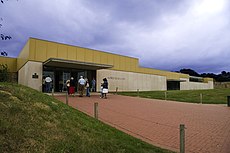Altamira Cave
| Altamira Cave
|
||
|---|---|---|
|
Cave painting of a steppe bison in the cave of Altamira ( replica , Museo Nacional y Centro de Investigación de Altamira , Santilla del Mar , Cantabria , Spain ) |
||
| Location: | Cantabria , Spain | |
|
Geographic location: |
43 ° 22 '39 " N , 4 ° 7' 9" W | |
|
|
||
| Discovery: | 1868 | |
| Website: | museodealtamira.mcu.es | |
The Altamira Cave near the town of Santillana del Mar in Cantabria , Spain , 30 km west of Santander , is known for its Stone Age cave paintings . Like the Chauvet Grotto, it is part of the Franco-Cantabrian cave art and is part of the UNESCO World Heritage .
photos
The cave contains about 930 Paleolithic images, including incised drawings , pure charcoal drawings and colored representations. Pictured are deer , bison , deer cows, horses and wild boar . Were used charcoal and red chalk , black manganese earth and various tinted ocher that were mixed with fat or protein. Feathers were probably used for the paint application. But colored pencils and tubular bones, through which the dye was blown up, or the application of paint by hand were also possible.
discovery
The Altamira Cave arches over an area of more than 5500 m². It was built from 33,600 BC. Until the collapse of the entrance 11,000 BC. Used. The particularly impressive ceiling paintings are dated 16,500 to 13,000 BC. Assigned. The cave was discovered in 1868 due to the disappearance of a hunting dog by a hunter who immediately reported the discovery to the landlord of Santillana, the naturalist Don Marcelino Sanz de Sautuola (1831–1888).
The paintings were discovered by Don Marcelino's five-year-old daughter Maria, who was able to enter the cave in an upright position and made out images of “cattle” on the ceiling. Marcelino began to dig systematically in the cave in 1879 and published a brief description of the "prehistoric objects in the province of Santander". Even the Spanish King Alfonso XII. was invited into the cave. The scholarly professional world, however, doubted the authenticity of the cave paintings.
The French prehistorian Émile Cartailhac described the paintings as “a vulgar prank by a smear”, which he and his contemporaries did not even want to look at. The discovery had to wait almost 23 years for recognition. Only when similar paintings in the cave of Font-de-Gaume near Les Eyzies-de-Tayac-Sireuil in the Dordogne department (France) became known in 1901 did the attitude of French research and Cartailhacs, the symbol of archaeological ignorance, change has been. Cartailhac apologized in 1902 in an essay ( Mea culpa d'un skeptique ) to the Marquis de Sautuola.
Preservation
The cave has not been open to the public since 1979, as the warm breath of the visitors caused severe damage and the paintings started to go moldy due to the newly attached wooden railings. In 1998 the Spanish Geography Institute was commissioned to reproduce the approximately 1500 m² entrance area true to the original. The cave was measured with approx. 40,000 measurement points per square meter and reproduced with foam sheets and faithfully painted mats.
presentation
The replica is shown in the visitor center built around 500 m from the historic cave. Other true-to-original copies can also be seen in the Deutsches Museum in Munich and in the Museo Arqueológico Nacional de España in Madrid .
In 1985 UNESCO put the Altamira Cave on the World Heritage List . In 2008 she added a number of other caves to this world heritage site, which also contain Paleolithic paintings. Since then, the world heritage site has been called the Altamira Cave and Paleolithic Cave Paintings in Northern Spain .
literature
- Antonio Beltran, Federico Bernaldo de Quiros, Pedro A. Saura Ramos, Federico Bernaldo de Quiros, Pedro A. Saura Ramos: Altamira. Speläo series . Jan Thorbecke Verlag , Stuttgart 1998, ISBN 3-7995-9005-6
- Hans Baumann : The caves of the great hunters . Sigbert Mohn Verlag , Gütersloh 1961
Web links
- Museo Nacional y Centro de Investigación de Altamira (Spanish)
- Entry on the UNESCO World Heritage Center website ( English and French ).
- Replica in the Deutsches Museum (1)
- Replica in the Deutsches Museum (2)
Individual evidence
- ↑ Bert Bilzer , Jürgen Eyssen , Otto Stelzer a . a .: The Great Book of Art. Photo book - Art history - Lexicon. Georg Westermann Verlag , Braunschweig 1958, p. 105 (caption)
- ↑ a b c d e Bilzer u. a. 1958, p. 101
- ↑ Chronology . In: Website of the Museo de Altamira . Retrieved May 9, 2019.










